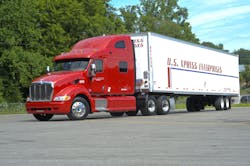U.S. Xpress: Study reveals technological fault lines of supply-chain management
According to truckload carrier U.S. Xpress, a study it recently conducted with more than 400 supply-chain executives has been eye-opening regarding the role of technology and its rate of adoption.
The carrier said the study has brought to light “some surprising findings and interesting insights into how shippers operate and what can be done-- especially in the area of technological enablement-- to control costs and secure capacity.” Specifically, it was found that more up-to-date data, better analytics and enhanced supply-chain visibility are all needed to better control both costs and capacity.
“The survey demonstrates that there is great variance among shippers in terms of the level of technology they employ in doing freight optimization,” explained John White, executive vice president of sales & marketing, U.S, Xpress Enterprises.
“However,” he continued, “regardless of what systems they are currently using, it is clear that more widespread and efficient use of transportation management systems, clearer supply-chain visibility, improved analytics, enhanced cooperation and data-sharing between carriers and shippers and more up-to-date data could go a long way toward optimizing loads and reducing costs for everyone involved. It is critical for carriers and shippers to work together to find mutually beneficial solutions.”
U.S. Xpress emphasized that the study showed that data-sharing and supply-chain visibility are “critical factors.” While nearly one-half of the respondents said they think their organizations have sufficient ability to share and exchange information with customers and suppliers, almost one out of five rated their firms as unfavorable in this regard.
The survey, conducted with Peerless Research Group, found that only 59% of shippers use performance metrics to manage freight costs and only 43%t are currently running-- or planning to implement-- a transportation management system (TMS).
A strong preference for dynamic optimization was also shown, with nearly three-fourths of all shippers preferring that their carriers use present, actual shipping data rather than historic data to set their rates. Less than 1 in 5 favor the use of historic or static data.
The survey confirmed the industry’s interest in just-in-time shipping, with 41% reporting booking freight one day in advance and more than four in five scheduling three or fewer days ahead.
Per the survey, the key strategies shippers use to control freight costs are:
· Consolidating shipments (60%)
· Improving decision-making and planning utilizing reporting (58%)
· Working with fewer partners (53%)
· Optimizing internal resources (52%)
· Implementing or planning TMS (39%)
· Adopting KPIs for carriers (38%)
· Working with more carriers (33%)
Surprisingly perhaps, the survey found that only around 4 out of 10 shippers are currently using any tool(s) to assess shipping costs-- relying instead on less sophisticated methods to gauge their shipping costs.
Among the 59% evaluating freight costs, the most common aspects of shipping being measured are spend by carrier (74%), cost by route (72%), on-time performance (68%), spend by shipment volume (66 %) and cycle time and carrier capacity (32% each).
U.S. Xpress pointed out that it’s also “clear from the study that many of those who are using a Transportation Management System are happy with it and 21% indicated their belief that they are using these tools to their fullest advantage and for multiple initiatives, from tracking and tracing and load and route optimization, to provide mode selection and real time-tracking.”
As for shippers seeking to advance their operations, these areas are earmarked for improvement:
· Load optimization– consolidation, backhauls, etc. (44%)
· Electronic communication– EDI, XML (44%)
· Billing and invoicing (39%)
· Reporting capabilities (37%)
· Integration of logistics/ transportation apps with other enterprise apps (34%)
